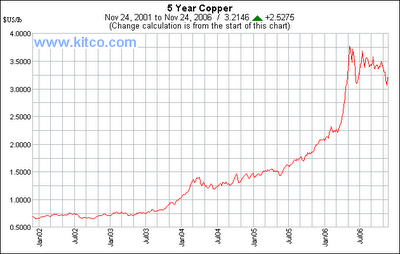The Copper Topped Economy
While many are quick to point to a global real estate bubble, they argue we are in a long term bull market for commodities including copper. Yet, as I have written time and again, there is zero precedence for such an argument. Sure, some commodities may violently rise and fall by large percentages for years but I don't call that a long term bull market. Bull market is defined by higher highs and higher lows not what we have seen historically.
In addition, since more than half of copper production appears to go into real estate, it's hard to argue we aren't in a copper bubble if one believes we are in a global real estate bubble. The amount of new copper production coming online in the next few years appears to be a pretty large number from what I have read. With copper in the biggest price bulge in over one hundred years (It is likely the largest bulge in the history of capitalism but I don't have any data points before 1900.), it's hard to imagine speculation hasn't fueled much of this massive blow off. The end of the commodity bubble this cycle likely happened in the massive run up in industrial commodities and said stocks in the first part of 2006. During a period of less than two months copper nearly doubled from approximately $2 a pound to nearly $4 a pound. This is consistent with the last phase of any mania including the doubling of technology stock prices in the 1999 blow off into the early 2000 peak. And, I don't care what anyone says, history will almost certainly prove this is a blow off. Copper actually reached levels of semi-precious metal status with its final violent rise.
Let me take this argument one step further and say that because commodities are traded globally in dollars, there is a reasonable conclusion to be drawn that we aren't in a commodities bubble but a sea of excess dollars. More dollars in the system means more dollars are required to buy the same amount of any dollar denominated asset. That may indeed be so. But, don't necessarily blame that on the Federal Reserve as I hope to point out soon enough in a post I've promised to get up for the last few weeks.
Now that copper, crude and gold appear to be resynchronizing, that is likely bad for all industrial commodities and a sign of weakening demand, an end to speculative fervor, excess supply building in the system or all of the above. The fair value for copper is likely 50 cents to a somewhere less than $2 not $3-4. Long term, I would be surprised if copper did not return to 6o cents. While there may be excess dollars in the system, this isn't the first time such a scenario has unfolded. Historically, this has never saved copper from cratering to the same support level it has had for the last fifty years. Things may be different this time but I'm not willing to bet my financial future on it.
The senior management team at Freeport obviously doesn't agree with history since they recently paid an astronomical sum for Phelps Dodge, the gigantic copper producer. Wouldn't it have made more sense to buy Phelps when copper was 60 cents in 2001? I would assume such an acquisition could have been made for about ten percent of the nearly $30 billion purchase price being paid today. But, then I suppose Freeport didn't have the cash to make this deal happen in 2002. If so, corporate management failed miserably in their ability to manage their financial position to take advantage of just such an opportunity. An opportunity that was clearly predictable.
Chart courtesy of Kitcometals.com



<< Home